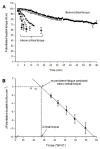Critical Power: An Important Fatigue Threshold in Exercise Physiology
- PMID: 27031742
- PMCID: PMC5070974
- DOI: 10.1249/MSS.0000000000000939
Critical Power: An Important Fatigue Threshold in Exercise Physiology
Abstract
: The hyperbolic form of the power-duration relationship is rigorous and highly conserved across species, forms of exercise, and individual muscles/muscle groups. For modalities such as cycling, the relationship resolves to two parameters, the asymptote for power (critical power [CP]) and the so-called W' (work doable above CP), which together predict the tolerable duration of exercise above CP. Crucially, the CP concept integrates sentinel physiological profiles-respiratory, metabolic, and contractile-within a coherent framework that has great scientific and practical utility. Rather than calibrating equivalent exercise intensities relative to metabolically distant parameters such as the lactate threshold or V˙O2max, setting the exercise intensity relative to CP unifies the profile of systemic and intramuscular responses and, if greater than CP, predicts the tolerable duration of exercise until W' is expended, V˙O2max is attained, and intolerance is manifested. CP may be regarded as a "fatigue threshold" in the sense that it separates exercise intensity domains within which the physiological responses to exercise can (<CP) or cannot (>CP) be stabilized. The CP concept therefore enables important insights into 1) the principal loci of fatigue development (central vs. peripheral) at different intensities of exercise and 2) mechanisms of cardiovascular and metabolic control and their modulation by factors such as O2 delivery. Practically, the CP concept has great potential application in optimizing athletic training programs and performance as well as improving the life quality for individuals enduring chronic disease.
Figures





References
-
- Allen DG, Lamb GD, Westerblad H. Skeletal muscle fatigue: cellular mechanisms. Physiol Rev. 2008;88:287–332. - PubMed
-
- Amann M, Romer LM, Pegelow DF, Jacques AJ, Hess CJ, Dempsey JA. Effects of arterial oxygen content on peripheral locomotor muscle fatigue. J Appl Physiol. 2006;101:119–27. - PubMed
-
- Bailey SJ, Vanhatalo A, DiMenna FJ, Wilkerson DP, Jones AM. Fast-start strategy improves VO2 kinetics and high-intensity exercise performance. Med Sci Sports Exerc. 2011;43:457–467. - PubMed
-
- Bailey SJ, Varnham RL, DiMenna FJ, Breese BC, Wylie LJ, Jones AM. Inorganic nitrate supplementation improves muscle oxygenation, O2 uptake kinetics, and exercise tolerance at high but not low pedal rates. J Appl Physiol. 2015;118:1396–405. - PubMed
Publication types
MeSH terms
Substances
Grants and funding
LinkOut - more resources
Full Text Sources
Other Literature Sources
Medical
Miscellaneous

